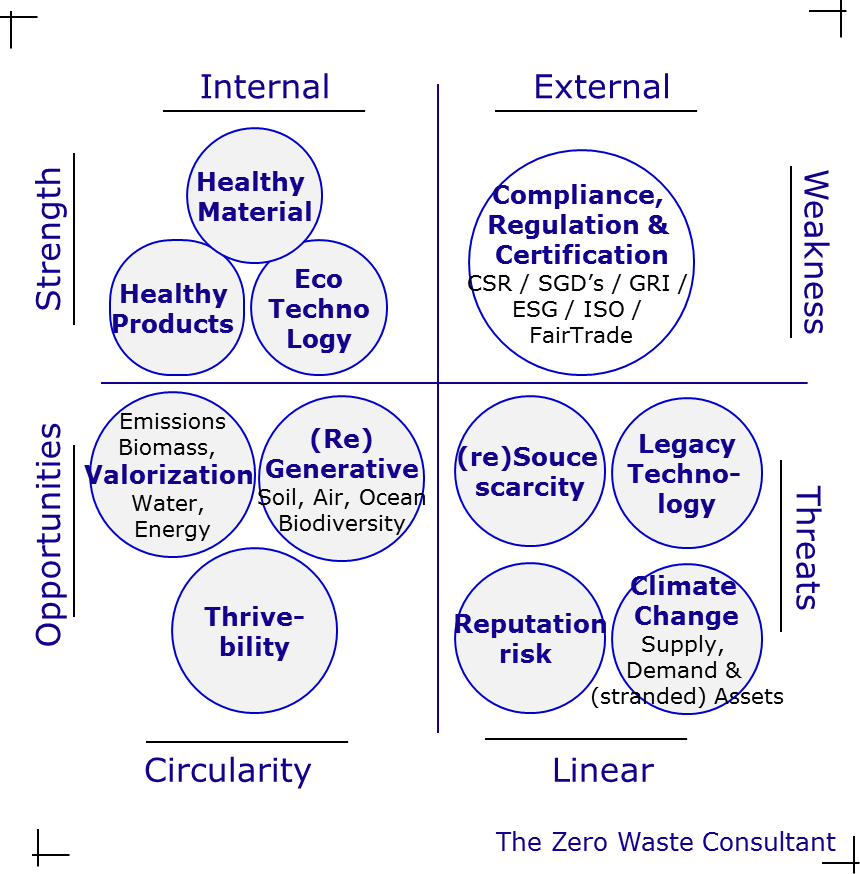While driving past all the new warehouses I could not wonder asking myself if we could design better logistic boxes which do much better that the current solutions. Lets image distribution centers that generate more cash flows and are also climate-positive for the benefit of the investor, user and lessor.
Concept
Distribution centers take up a large amount of space, with the roof, walls and floor/foundation being the largest users of space. This shell construction is necessary to facilitate the indoor activity for the lessor. And knowing that soils and air are necessary for buildings, it is important to realize that buildings are therefore an integral part of the natural environment.
Now suppose that the building (the actual shell) is the revenue model and is capable of generating cash flows (with or without the tenant). Based on various physical, biological and chemical principles, the roof, walls (including the facade) and floor/foundation can make an additional financial contribution to the traditional revenue model for distribution centers.
By starting from the envelope (its shell), it first becomes possible for the building to fully meet its own needs, such as energy (electrons and heat generation/storage), indoor climate (natural cooling) and water buffering (roof and road surface). By focusing on maximizing energy (electrons and heat) and water collection, it becomes interesting to distribute the remainder in batteries and in the environment to homes, sports fields and business locations.
The interesting thing about a different use of the envelope is that aspects such as climate adaptation, nitrogen balance, climate neutral/positive, CO2 reduction, water collection, the living environment (biodiversity, oxygen production, cleaner air, etc.) are integrally included, thereby tackling several transition challenges at the same time. dissolved.
It can be made more exciting if biological processes also become part of the envelope, such that the roof and facade produce biomass and are harvested periodically.
A multi-functional shell that offers more advantages on several fronts:
-> Generating your own electrons reduces pressure on the central electron network, provides security of supply and constant electron costs
-> Generating your own heat provides security of supply and constant heat costs
-> Natural cooling reduces energy/heat requirement
-> Heat stress reduction (less warming) results in a better local climate
-> A living facade purifies the air, produces oxygen (much needed in built-up environments) and binds CO2 and nitrogen, among other things
The goal is to strive for
-> Decentralized energy production & distribution
-> Energy independence for the tenant, resulting in lower operational costs
-> Adaptive to rising temperatures due to climate change
-> Water buffering and replenishing local groundwater
-> Adaptive & positive contribution to local climate conditions
-> Contribution to increased local biodiversity
Do you dare to set a new standard for distribution centers, which is good for your wallet, that of the tenant and the living environment?
Here are some examples of existing solutions:
Energy (electrons and heat) extraction/pump
Solar panels can be placed next to the roof and also on the facades. The proceeds can be used for charging electric vehicles, for own electron needs and for distributing the surplus to the grid or the surrounding area.
Ref: Ibis Power
Ref: Copenhagen International School
Ref: Façade panels with an invisible thermal solar collector for energy
Ref: Kinext – S4 Energy (flywheel)
Ref: Bullit Building Seattle
Ref: Microbial Fuel Cells
Heat recovery
Façades (and also the roof) can capture the heat from the sun and store it in the foundation of the distribution center for days when it is colder, or it can be stored in the soil with a heat exchanger.
Ref: BIQ house (algae production as a facade)
Ref: Phase changing materials
Ref: Engie heat recovery emissions
Ref: heat exchangers in walls
Natural ventilation
Natural heat/cold extraction makes it possible to make less use of air conditioners (which saves electrons and limits installations), whereby heat exchangers can provide temperature regulation in cooperation with the outer wall/roof/foundation. Heat exchangers cool the warm air and buffer it in the foundation. It gets even better if the building is built 2 meters deeper to integrate the natural cooling of the soil into the heat exchanger.
Ref: Passiv haus institute
Ref: trox
Ref: Otflow
Ref: Earth, wind & fire – Dr. Ing. Ben Bronsema
Asphalt for heat, electrons and water buffer
The asphalt around the distribution center can be used to generate more heat or to generate more electrons. A water buffer can also be installed under the waste and another part can be topped up with the groundwater.
Ref: Endless energy
Ref: Drainphalt
Ref: Buffer block
Increasing biodiversity
A green roof in combination with green facades helps to purify the air (CO2, nitrogen and particulate matter) in the environment and also to provide the environment with extra oxygen. In such a way that the distribution centers imitate the function of a forest and thus contribute to the living environment
Ref: Venlo Town Hall
Ref: Testa Produce in Chicago
Ref: Declining Oxygen Level as an Emerging Concern to Global Cities [ https://www.frontiersin.org/articles/10.3389/fphys.2021.571137/full ]


